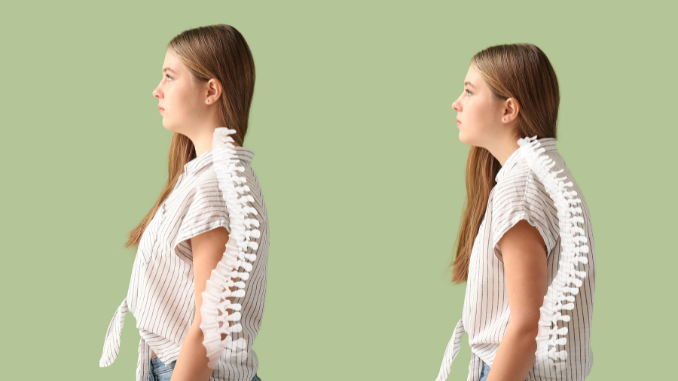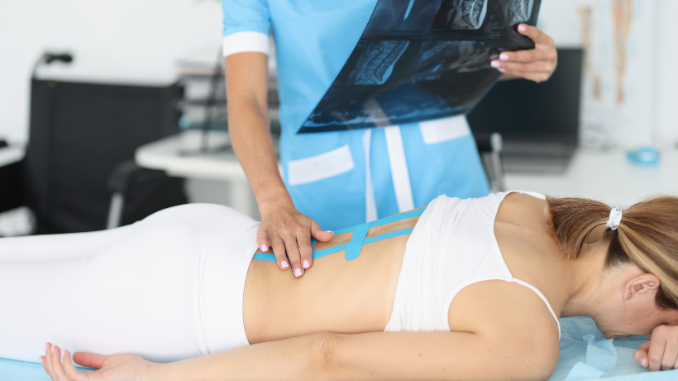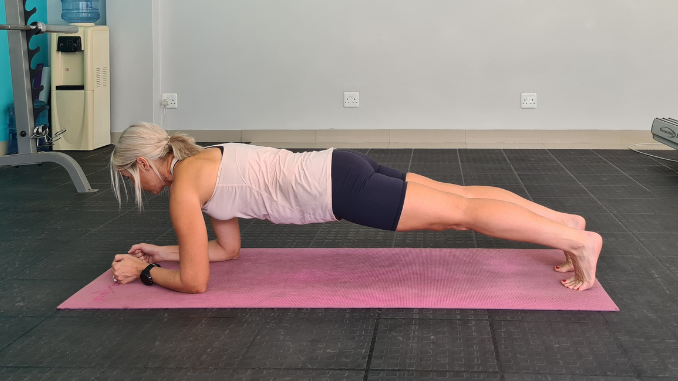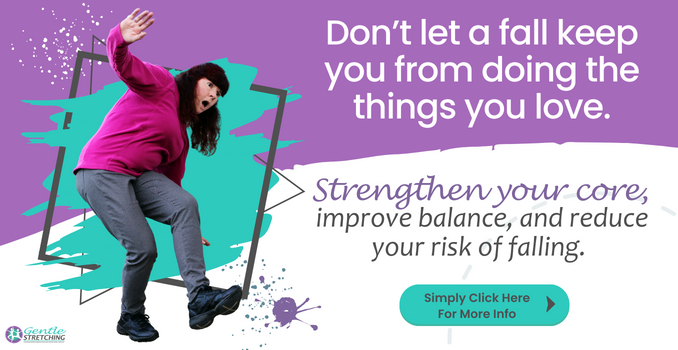
Yoga For A Balanced Spine: Managing Scoliosis Through Mindful Movement
In the graceful blend of mindful breathing, purposeful movement, and heightened self-awareness, yoga's seemingly simple poses reveal their unique ability. This is to address the complexities of scoliosis—a condition defined by a lateral curvature of the spine. Let's talk about some Yoga for Scoliosis in this article.
Discovering well-being and empowerment is within reach for those navigating the challenges of scoliosis. All thanks to the age-old practice of a simple yoga pose. Despite simple movements and stretches, yoga offers more than traditional agility and strengthening exercises for scoliosis. It does not simply target the muscles of the body but also the minds of individuals.

This article is your gateway to a world where warm-up exercises and Yoga for Scoliosis are your allies, tailored to nurture alignment, balance, and overall vitality. Join us on this journey, and let's explore how yoga can empower you to embrace life with scoliosis, unlocking a world of renewed strength and well-being.
Understanding Scoliosis
Scoliosis is a health condition identified by an irregular lateral (side-to-side) curvature of the spine.
When viewed from behind, a person's spine with scoliosis may appear as a C-curve or S-curve shaped instead of a straight line.
Individuals of all ages may be affected by this condition, ranging from children to adults. While the cause of scoliosis varies, it often arises without a clear trigger, making it known as idiopathic scoliosis.
People living with Scoliosis typically experience the development of this spinal curve in different areas of their back, namely the cervical spine (neck), thoracic spine (upper back), or lumbar spine (lower back) regions.
The fascinating aspect of Scoliosis lies in diverse the condition presents itself.
The degree of curvature can vary widely, spanning from mild to severe, and bending the neutral spine to create a convex and concave side with the rib cage of an individual's body.

In mild Scoliosis, the impact on a person's daily life tends to be minimal. Often, individuals may not be aware of the condition until it is detected during a routine medical examination. However, the story shifts when Scoliosis takes on a more severe form.
In such cases, discomfort, pain, and a palpable restriction in mobility can significantly hinder an individual's journey. The challenges posed by severe Scoliosis should not be underestimated. People with Scoliosis feel the weight of gravity constantly. The continual pull of certain parts of the back makes it hard for them,
Understanding The Key Aspects Of Scoliosis
Understanding the key aspects of Scoliosis is crucial for scoliosis patients and their physical therapists. Appropriate management is essential for individuals with Scoliosis to optimize their treatment outcomes and create proper alignment. A quick intervention can help mitigate the condition's progression. Also, it can alleviate discomfort, and promote a healthy spine, but it cannot cure Scoliosis if left for too long.
The Role Of Yoga In Treating Scoliosis
Yoga is emerging as a valuable and holistic approach to managing scoliosis—a condition characterized by an abnormal structural alignment of the spine. Yoga offers numerous benefits that can help individuals alleviate discomfort, improve posture, and enhance overall well-being.

1. Enhancing Posture And Alignment
In yoga, the primary emphasis is on using mindful movements to create alignment in the body, improve balance, and have more awareness, making it a valuable practice for individuals with scoliosis. Through regular practice, individuals with scoliosis can become more attuned to their body's alignment and make conscious adjustments to improve posture.
2. Strengthening Core Muscles
Maintaining a strong core is crucial for stabilizing the spine and promoting improved posture. Many yoga poses target the core muscles, helping build strength in the abdominal muscles and the upper back muscles. A stronger core can provide better support for the spine and lower the likelihood of developing a major curve on the entire body.
3. Improving Flexibility
A consistent yoga routine promotes flexibility and range of motion, benefiting individuals with scoliosis. Increased flexibility in the spine can help reduce pain and discomfort associated with the scoliosis curve. As time passes, less pain will be felt, and the s-shape curve of the spine will be fixed in no time. If not, then it can promote the improved posture of the individual.
4. Reducing Pain And Discomfort
Scoliosis can lead to the usual distortions, such as muscle imbalances and discomfort. Yoga's gentle stretches and poses can alleviate tension in the muscles surrounding the spine, relieving people with scoliosis. Mindful breathing techniques can also help manage the pain and promote relaxation, encouraging venous blood return.
5. Mind-Body Connection
Yoga emphasizes the strong connection between the mind and body. Through mindfulness and meditation practices, some consider yoga a therapeutic recreation. This heightened awareness can help individuals identify the usual distortions caused by scoliosis and address these issues more effectively.
Overall, the movements of yoga aim to not only focus on the mind but the body as well. Particularly the rib cage and other parts associated with the spine, ultimately leading to improved stability and posture in daily life. Yoga can also help eliminate the concave side and the convex side created by the abnormal curvature of the spine, offering better support for the various parts of the upper back and reducing the strain on the affected area through healing movements.
Types Of Scoliosis

-
Idiopathic Scoliosis
Idiopathic scoliosis, constituting roughly 80% of cases, stands as the prevailing form. It typically emerges during adolescence, usually between the ages of 11 and 18, known as adolescent idiopathic scoliosis (AIS). The term "idiopathic" indicates that the exact cause is unknown.
Genetic factors are believed to contribute significantly to its advancement, given its tendency to occur within families suffering from the same condition. Idiopathic and degenerative scoliosis often get mixed due to how common they are.
-
Degenerative Scoliosis
This type of scoliosis primarily affects older adults and is associated with age-related changes in the spine. Over time, disc herniation happens, making people with scoliosis lose their flexibility and height, and the facet joints may experience wear and tear. As a result, the spine may undergo gradual misalignment, leading to scoliosis.
Individuals with abnormal curvature of their spine may experience pain, stiffness, and reduced mobility in addition to the spinal curvature. Management may involve pain relief measures, physical therapy, and, in severe cases, surgery to stabilize the spine.
-
Congenital Scoliosis
It is a type of scoliosis present at birth and results from abnormal development of the normal spine into spinal curves during fetal growth. It occurs when the vertebrae fail to form properly or fuse, leading to irregular curvature of the thoracic spine.
Genetic mutations may lead to the onset of this condition or other factors such as exposure to toxins or infections. The severity of congenital scoliosis varies, with some cases requiring people with scoliosis to undergo surgical intervention because the curvature is beyond help and rejuvenating movements.
-
Syndromic Scoliosis
Syndromic scoliosis is linked to specific genetic syndromes, such as Marfan syndrome, Down syndrome, or Ehlers-Danlos syndrome. These syndromes often involve inherent skeletal abnormalities, such as affecting the right or left leg, and muscular imbalances that contribute to developing lumbar or thoracic spine scoliosis.
To effectively manage syndromic scoliosis, healthcare professionals adopt a multifaceted strategy that addresses the physical manifestations of the scoliosis curvature and considers the broader context of the genetic syndrome at play.
-
Structural Scoliosis
Structural scoliosis is a type of scoliosis characterized by a permanent and fixed curvature of the spine. This type of scoliosis can result from various underlying causes, including abnormalities present at birth, problems without a clear cause, changes related to aging, medical conditions, or even sports-related injuries.
The condition progresses slowly, especially during rapid growth, such as adolescence. Individuals with this type of scoliosis need to undergo regular monitoring. Early detection and intervention can assist in reducing the advancement of the curvature.
Yoga Poses For Scoliosis
1. Forward Fold
Begin in an upright standing position with your feet hip-width apart, maintaining a good alignment with your head, shoulders, hips, and legs. Tighten your core and hinge through your hips to bend your upper body forward. Slowly lower your head and arms to reach for your toes while keeping your legs straight. Hold this position for several deep belly breaths, in through your nose and out through your mouth. Repeat the movement for 2 - 5 repetitions.
 |
 |
2. Child Pose
Begin in an upright kneeling position on the floor with your knees wider than shoulder-width apart. maintaining a good alignment with your head, shoulders, and hips. Tighten your abdominal area. Shift your hips back to your feet and extend your arms in front. Drop your forehead on the floor, relaxing your mid-back area for a light stretch. Hold this position for several deep belly breaths, in through your nose and out through your mouth.

3. Forearm Plank
Begin in a 4-point position with your knees below your hips and your hands beneath your shoulders. Lower to your forearms and step your feet back to move into a forearm plank position, maintaining good alignment with your head, shoulders, hips, and toes. Hold this position for several deep belly breaths, in through your nose and out through your mouth.

4. Sphinx Pose
Lie on your stomach with your feet shoulder-width apart, maintaining good alignment with your head, shoulders, hips, and legs. Place your hands at your sides with your elbows beneath your shoulders, spreading your fingers wide for a good base of support. Breathe in, then press up and arch your back, using your glutes and back muscle strength. Pull your forearms toward you to open up your chest. Hold this position for several deep belly breaths, in through your nose and out through your mouth.
For a more intense exercise, you can lift and tilt your head back even further.

Tips And Tricks For An Effective Yoga Session
-
Get Help
For an effective yoga session with scoliosis, start by consulting with a physical therapist or certified yoga instructor to guarantee a safe and tailored practice. Find yourself a friend to watch you as you engage in your sessions to assist or help you if something goes wrong.
If you are having difficulty with your yoga practice or you're lacking the motivation to perform yoga postures, it is best to join a yoga class instead. Having a professional teaching yoga or just being around yoga students with the same goal as you can help motivate you through your sessions, be consistent, or just be there to generally provide help to people who are having difficulties.
-
Customize Your Poses
Incorporate alternative twisting poses, breathing awareness exercises, and holding poses for spinal mobility, these include the mountain pose, the plank pose, or the downward-facing dog . Listen to your body, modify poses as needed to decrease pain to avoid placing uneven pressure on the body.
Focus on maintaining proper alignment when modifying poses, especially in the thoracic region of the spine. Increase or decrease the intensity of the movements as you see fit, and target the necessary, yet obscure parts of the body such as the concave side or the convex side created by the bending of the spine and misalignment of the rib cage. However, don't make it too easy that it eliminates the challenge entirely.

-
Be Consistent
When practicing yoga, it is important to do it every day, as results will take time to show unlike regular exercises. However, it does not mean you should rush things. Instead, approach your practice with patience, gentleness, and a commitment to self-care. Always remember to take deep breaths and that progress may take time.
By staying consistent with your yoga practice, you not only help your spine curves but also enjoy benefits in all aspects of your life. Your back muscles get stronger, spine curves improve gently, and your overall posture gets better. Your daily dedication to yoga brings rewards that go beyond just physical changes. It creates a deep sense of balance, resilience, and well-being for both your body and mind.
Conclusion
Yoga presents a unique and tailored approach to address the challenges posed by scoliosis—the condition known by the lateral curvature of the spine. Through a combination of warm-up exercises and carefully chosen yoga poses, individuals with scoliosis can embark on a journey toward holistic well-being. Also finding solace and empowerment in their practice.
As we have explored the causes of scoliosis, the role of yoga poses, as well as tips and tricks to enhance your sessions we found that regular yoga practice promotes relaxation. It also reduces muscle tension, and alleviates pain—common concerns for those with scoliosis sufferers. However, it is essential to approach yoga with caution.
In conclusion, by approaching their practice with patience, gentleness, and a commitment to self-care, individuals with scoliosis can enjoy a fulfilling and supportive yoga practice. Progress may take time, but the journey toward enhanced physical and mental well-being is well worth the effort.
Through yoga, individuals with scoliosis can find balance, relief, and a path to a more balanced spine and a healthier, happier life.
You can improve your balance, body awareness, and connection to your body by practicing the yoga poses listed in this program which includes. Check out our 10 Yoga Poses to Make Your Body Fall-Proof program that is specifically designed if you have trouble with your balance due to age, illness, or injury.

